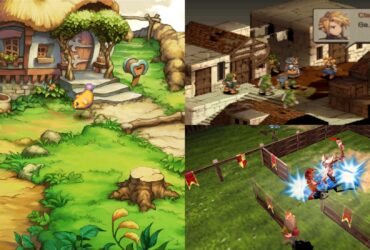Video game adaptations of popular anime can be a tricky proposition. Developers need to simultaneously cater to longtime fans who know the story and characters by heart while also encouraging those just looking for an enjoyable game experience to give their title a shot. It’s a careful “threading of the needle” that several games have pulled off successfully, capturing what fans love about the manga and anime while also providing compelling gameplay. Fairy Tail 2 finds itself following up 2020’s Fairy Tail, albeit with Gust taking over developmental duties this time. Like its predecessor, Fairy Tail 2 is a game that does a commendable job bringing the series to life, even if its gameplay elements fall a bit flat at times.
Prior to the modern Fairy Tail games, the series’ only video game adaptations were a pair of Japanese-exclusive PSP titles that never received localizations. The release of Fairy Tail in 2020 was a welcome surprise for longtime fans of the incredibly popular Fairy Tail manga and anime, adapting the series’ first major arc into an RPG with some light-tactical combat. Notably, though, Fairy Tail fell short of fans’ expectations by breezing through several important story beats despite otherwise bringing the fantasy world of the anime to life. Fairy Tail 2 does a great job capturing and retelling the climactic final arc of the series (and switching up its combat system to something more engaging), but its top-notch presentation and visuals can only do so much to distract from the game’s lack of depth.

Related
Fairy Tail: 18 Most Powerful Characters In The Series, Ranked
Every nook and cranny of the kingdom of Fiore, and the continent of Ishgar at large, is bursting with ethernano. Which wizards wield it best?
Fairy Tail 2’s Presentation is Top-Notch, But its Story Takes a Backseat
The first thing players will notice when playing Fairy Tail 2 is the work that Gust has put toward capturing the look and feel of the Fairy Tail anime. The cel-shaded visuals perfectly capture the world of Fairy Tail similar to other recent video game adaptations of popular anime series, with the bright colors and interesting characters of Fiore giving Fairy Tail 2 an adequately magical feel. Animations look particularly fluid, giving off the impression that playing Fairy Tail 2 is tantamount to getting to control an actual episode of Fairy Tail. But when it comes to how the game’s vibrant presentation is utilized to adapt the Alvarez Empire arc from the show, Fairy Tail 2 proves to be a bit of a mixed bag.
The Alvarez Empire arc of Fairy Tail involves a climactic showdown between main protagonist Natsu Dragneel and his arch-nemesis, the evil wizard Zeref. Fans of the series will no doubt know all the major twists that are revealed during the course of the arc, which Fairy Tail 2 blitzes through at an uncanny pace. One of the chief complaints lodged at the first Fairy Tail was its tendency to rush through important story beats and not give them the gravity they deserved, and that problem has persisted into Fairy Tail 2. Without delving into spoiler territory, character deaths, in particular, lack weight. Important members of the guild will unexpectedly die after key battles only for the game to quickly move past it, and those same characters reappear with absolutely no context a few minutes later. As a result, any emotional pull such an event might have had is completely lost, and the same can be said for several of the major late-stage reveals toward the end of the main quest.
As someone who has only a passing knowledge of the Fairy Tail manga and anime, it’s worth pointing out that Fairy Tail 2 does a commendable job of introducing the series’ characters and world. Things start off simply enough with players controlling protagonists Lucy and Natsu before the available roster opens up to include every major member of the Fairy Tail guild. Additionally, the game goes to great lengths to bring up-to-speed players who, like myself, either didn’t play the first Fairy Tail or have little to no knowledge of the series. Similar to Final Fantasy 16‘s “Active Time Lore” feature, players can pause Fairy Tail 2 at any moment to pull up the “Database”, checking out information on characters and their backgrounds. It’s even possible to uncover additional details about their personalities and backstory by leveling them up and watching the party-centric “Fairy Tail Diaries” custscenes at save points (represented by campfires).
But there again, those cutscenes (which, presumably, are supposed to endear the player to the characters and show how the guild builds camaraderie) are so numerous and one-dimensional that it quickly becomes a chore to sit and view all of them when resting at a campfire. You’ll unlock additional cutscenes that flesh out the story of the Fairy Tail guild and its members as you level up, but there’s no real benefit to viewing them other than gaining some insight into the interpersonal relationships among the heroes. The same can be said for just about every other story element that Fairy Tail 2 presents, which are meant to get newcomers up to speed on the franchise’s past but are light enough on information as to have no real bearing on the game’s narrative. Neither longtime series fans nor those with a passing interest benefit from how Fairy Tail 2‘s story is delivered, which begs the question of just who it’s for.
RPG Systems and Progression in Fairy Tail 2 Are Efficient But Lack Depth
Fairy Tail 2‘s gameplay unfortunately suffers from a similar lack of depth as its narrative delivery. As players unlock more characters and grow their roster of available heroes, they’ll eventually control three characters that they can use to explore the world of Fiore. At certain points, some of these characters will leave the available roster for story reasons, only to return later after reuniting with the main party. Regardless of what point in the game you’re at, it’s possible to switch between any of your available heroes at a moment’s notice, even choosing the character you use to navigate Fairy Tail 2‘s semi-open world maps.
The core gameplay loop of Fairy Tail 2 involves exploring the map, taking on side quests in between heading from one main quest marker to the next, and fighting enemies. In typical RPG fashion, characters will level up after accruing enough experience, getting to allocate stat points (dubbed “Origin Points”) across three distinct Magic Origin skill trees related to Spirit, Skill, and Strength. Fairy Tail 2 gives players the option to auto-level their heroes, which I found to be the best approach thanks to the order in which you acquire skills not really having any bearing on gameplay. On the standard difficulty setting, it’s very rare that fights will cause players trouble, and I was often over-leveled in each section of the map (indicated on the HUD) by just fighting every enemy I came across during my travels.
Other than unlocking new skills to use in battle, the Magic Origin trees are where players will level up basic stats shared among party members, as well as increase the effectiveness of special in-battle abilities that capitalize on different hero synergies. Gear and equipment are similarly limited in Fairy Tail 2, with players only having access to Lacrima as equippable items. Lacrima are magical crystals that can be imbued with power in the Fairy Tail universe, and they serve a similar purpose in Fairy Tail 2. Exploring the map and collecting item drops (whether from treasure chests or combat) rewards crafting materials that players can exchange with merchants for different Lacrima. There are Lacrima that boost the rate or damage of critical hits, elemental affinities, or even reward HP upon each successful attack. But while the Lacrima themselves are helpful in the context of gaining an edge in combat, the crafting system at play seemingly has no rhyme or reason to it. There are dozens upon dozens of different items that go into crafting the Lacrima, and you’ll collect so many of them that you’ll seemingly never run out of resources to outfit your heroes with the current best gear.
Perhaps even more confusing is the fact that, by the end of the game, there were still several Lacrima I had never gotten the chance to craft, despite having explored every region of the map. Fairy Tail 2 is split into Chapters, with the first half of the game covering the aforementioned Alvarez Empire arc from the manga and anime. The second half of the game is a sort of “endgame” or “post-game” featuring an original story by series creator Hiro Mashima, and while there are several mysterious items and upgrades that became available during that second half, there were still some items that remained inaccessible by the time I had completed Fairy Tail 2. Ultimately, Fairy Tail 2 streamlines several of its RPG systems to focus on the actual moment-to-moment gameplay, but it does so at the cost of sacrificing any meaningful sense of progression.
Combat is What Carries the Fairy Tail 2 Experience
The star of Fairy Tail 2, and what ultimately carried the experience for me, was the game’s combat. Fairy Tail 2 switches up its combat system from the first game to incorporate a mix of turn-based and real-time combat. Gone are the grids and light turn-based tactics of the first Fairy Tail, and in their place is an engaging system that mixes field encounters, break gauges, cooldown timers, and plenty of other interesting mechanics that contribute to a surprisingly deep combat model. While the other elements of Fairy Tail 2 might err toward accessibility and lose some depth as a result, Fairy Tail 2‘s combat offers a lot for players to sink their teeth into.
While exploring Fairy Tail 2‘s world, players will come upon groups of enemies that they can either run into or hit to gain an advantage at the start of battle, with the three player-controlled heroes sometimes taking on up to 9 or 10 enemies in a single encounter. There are single-target, area of effect, and all-target attacks at each character’s disposal, which offers a lot of flexibility in how players approach the quasi-turn-based battles. Instead of actual “turns”, combat in Fairy Tail 2 is dictated by cooldown timers and building up a gauge for using abilities known as “SP”. Once players have enough SP, they can activate special abilities that are far more effective than the standard melee attack, sometimes even wiping out whole squads of enemies in a single turn. And, in a move similar to Shin Megami Tensei V and Metaphor: ReFantazio, reaching certain level thresholds allows players to use real-time attacks to wipe out enemies in the field without ever engaging them in battle.
Tougher enemies (bosses and super-bosses) will have yellow “Break Gauges” that need to be depleted before dealing any substantial damage, which turns those encounters into a fun and frenetic race to stagger powerful enemies and disrupt their similarly powerful attacks before they can wipe out your party. Speaking of super-bosses, each region has an optional high-level encounter that players can attempt, and doing so is well worth the effort thanks to how fun and engaging those battles are, as well as how worthwhile the rewards can be. In terms of its difficulty, it demands mentioning that I never saw a “Game Over” screen once when playing through Fairy Tail 2 on the standard settings, and anyone with experience playing RPGs will likely have a similar experience. That said, the lower difficulty curve is by no means a bad thing, as it results in Fairy Tail 2 being a brisk experience where you’ll be hopping from one encounter to the next.
But, like the other elements in Fairy Tail 2, combat will eventually start to wear thin by the time players make their way toward the end of the experience, especially as challenging boss fights give way to frustrating battles of attrition against the game’s “big bads”. Fighting an interesting boss once is great, but less so when you have to fight that same boss three times in a row with no discernable change in mechanics or difficulty.
Completing the main quest of
Fairy Tail 2
is roughly the game’s first half, with the back half of the game reserved for post-game content featuring an original story and some more challenging encounters. By the time I had rolled credits on the main story, my play time was around the 23 hour mark, with another 15 or so hours spent completing some of the endgame missions. Altogether,
Fairy Tail 2
‘s brisk pacing complements its shorter runtime, with most playthroughs likely landing around the 40 hour mark to see and do everything the game has to offer.
Like the anime it’s based on, Fairy Tail 2 is a case of too much style and not enough substance. Despite its popularity, Fairy Tail has seemingly never been able to escape a reputation for being too formulaic, adhering to the style and qualities of Shonen anime just a bit too close for comfort. Similarly, Fairy Tail 2 is a game that ticks all the right boxes for a brisk and low-stakes RPG, but it lacks the depth that other similar games might offer. It’s a title that players’ enjoyment of will vary depending on their appreciation of the Fairy Tail manga and anime, with its snappy combat and eye-catching visuals the definitive silver lining of what’s otherwise a fairly shallow experience.

Tactical
RPG
Hack and Slash
- Released
- December 11, 2024
- ESRB
- T For Teen: Fantasy Violence, Mild Language, Suggestive Themes
- Eye-catching visuals that do the Fairy Tail manga and anime justice
- Engaging combat system that blends turn-based ability juggling with real-time button inputs
- RPG systems and character progression take a back seat in favor of streamlining the experience
- A lack of depth on all fronts, from the gameplay to the presentation of the manga’s climactic Alvarez Empire arc
- Several underbaked mechanics that don’t contribute to the experience in any meaningful way
Fairy Tail 2 release December 11, 2024 for PC, and December 13, 2025 for PS5, PS4, and Switch. Game Rant was provided a PS5 code for this review.












Leave a Reply